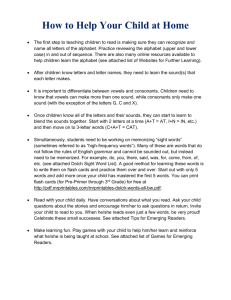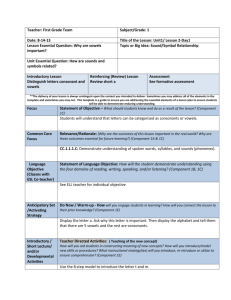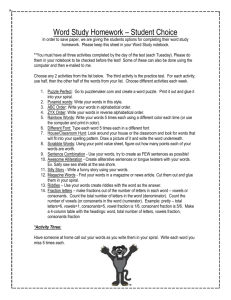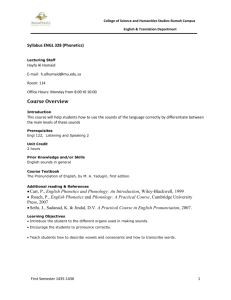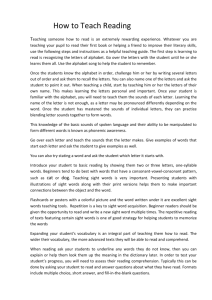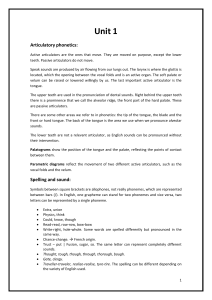RE 5100 Final Exam
advertisement
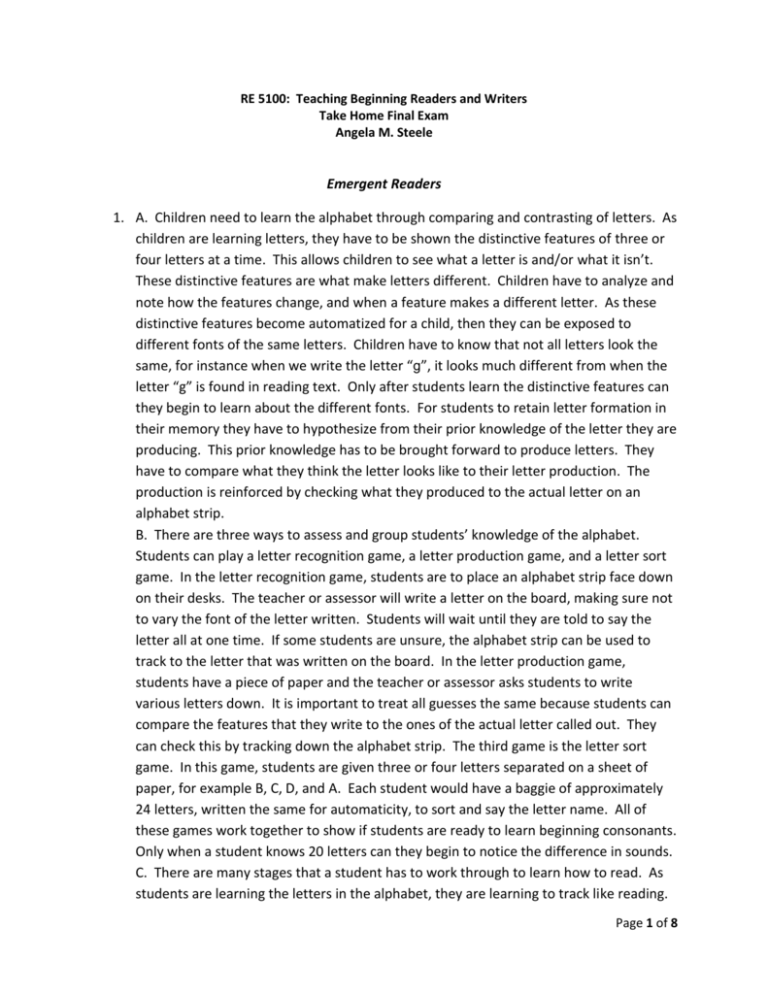
RE 5100: Teaching Beginning Readers and Writers Take Home Final Exam Angela M. Steele Emergent Readers 1. A. Children need to learn the alphabet through comparing and contrasting of letters. As children are learning letters, they have to be shown the distinctive features of three or four letters at a time. This allows children to see what a letter is and/or what it isn’t. These distinctive features are what make letters different. Children have to analyze and note how the features change, and when a feature makes a different letter. As these distinctive features become automatized for a child, then they can be exposed to different fonts of the same letters. Children have to know that not all letters look the same, for instance when we write the letter “g”, it looks much different from when the letter “g” is found in reading text. Only after students learn the distinctive features can they begin to learn about the different fonts. For students to retain letter formation in their memory they have to hypothesize from their prior knowledge of the letter they are producing. This prior knowledge has to be brought forward to produce letters. They have to compare what they think the letter looks like to their letter production. The production is reinforced by checking what they produced to the actual letter on an alphabet strip. B. There are three ways to assess and group students’ knowledge of the alphabet. Students can play a letter recognition game, a letter production game, and a letter sort game. In the letter recognition game, students are to place an alphabet strip face down on their desks. The teacher or assessor will write a letter on the board, making sure not to vary the font of the letter written. Students will wait until they are told to say the letter all at one time. If some students are unsure, the alphabet strip can be used to track to the letter that was written on the board. In the letter production game, students have a piece of paper and the teacher or assessor asks students to write various letters down. It is important to treat all guesses the same because students can compare the features that they write to the ones of the actual letter called out. They can check this by tracking down the alphabet strip. The third game is the letter sort game. In this game, students are given three or four letters separated on a sheet of paper, for example B, C, D, and A. Each student would have a baggie of approximately 24 letters, written the same for automaticity, to sort and say the letter name. All of these games work together to show if students are ready to learn beginning consonants. Only when a student knows 20 letters can they begin to notice the difference in sounds. C. There are many stages that a student has to work through to learn how to read. As students are learning the letters in the alphabet, they are learning to track like reading. Page 1 of 8 The best way to teach the alphabet and this tracking is to teach students the alphabet song, making sure to slow down and emphasize L, M, N, O, P. To recognize letters in isolation, practice letters with the alphabet strip down, (Letter Recognition Game). As students learn the letters, they then begin to recognize letters in isolation, through letter sorts. This begins student learning of self correction. As students move to producing letters in isolations, they are beginning to spell words. This cannot be taught until a child is spelling/producing random letters. This is simply taught by having students to write various letters, Letter Production Game. As students are learning letters, they have to be able to sort. As students develop their knowledge of letters, they are then challenged for quickness. This letter sort quickness strengthens the automaticity of their letter knowledge. 2. A. To conduct a language experience with students spelling in the letter-like stage, a short dictation could be taken about a common class experience. In a dictation, the teacher writes down in the student’s language, word-by-word, their story. Upon taking this dictation, it can be written down in the form of a book. In this book, there would only need to be three to six words on a page. Limiting the words on the page encourages accurate tracking and self correction. At this stage, students can self correct by using beginning and ending consonants. Longer personal narratives could be made for an individual child because this dictation would be in their own language about their personal experience. This story will be a unique experience for the individual child, allowing for a longer dictation. B. For students beginning to spell with some logical beginning consonants, you would take the dictation, and draw attention to the beginning sounds of each word. You would ask the student about the beginning sounds that they hear, to aid in your writing of the dictation. This is where they can use their knowledge of self correction by applying what they know. Instead of writing three to six words on the page, you would increase the words to eight to ten words. This still emphasizes correct tracking, but increases the opportunity for the student to possibly get off track. 3. A. Students who are spelling with random letters may point to words of a memorized text. This for the most case is done when words are monosyllabic. They are pointing to the stress units, not necessarily the words. They say a stressed word or group of words because they are listening to the patterns or prosody of a story. These children do not have phonemic awareness. Page 2 of 8 B. Children begin to spell with beginning consonants because this is the more salient part of a word. Often in spoken language, we do not enunciate the ending as much as the beginning; therefore, the ending comes at a later time, when they become more aware of the concept of word. These children often begin tracking by pointing to one syllable at a time. Since children are born with the LAD, they are continuously making hypotheses about language. Their first hypothesis is that our language is a syllabury – one syllable per symbol (Japanese and Chinese characters). Eventually children figure out that this hypothesis doesn’t work, this is where their attention begins to focus on beginning consonants. For instance, when a child says “Sam”, the sound they hear is “s”; therefore, they focus on the beginning of a word. This is where self correction can now be taught. 4. A. A child is ready to learn beginning consonants when they are pointing to words and saying syllables and know at least 20 letters of the alphabet. Knowledge of beginning sounds is where self correction occurs. At this stage, a child is partially aware of the concept of word. The teacher can use this knowledge in their reading, to point out the word/sound relationship. For example with “Sam, Sam”, if a child says baker, but points to the words baker and man, you can point out that man does not start with the “k” sound. This is how the child self corrects. B. Picture sorts are a better way for students to learn beginning consonant sounds. Some letters share similar sounds, for example s and c. Therefore, teaching the letters in isolation can be confusing to the child. The picture card sort works much like a letter sort. These sorts are based on contrasting features in columns and within columns. C. Picture sorts are used because students do not have a large enough sight vocabulary to support using word sorts. Students cannot read, but they can identify pictures of different things. Beginning Readers 1. When a child is spelling with beginning and ending consonants, they are partial phonemic aware, forming a foundation for the concept of words. They acknowledge both the beginning and ending consonant sounds. They begin to understand that when they say –ly that the next word doesn’t begin with the “l” sound. This allows them to track accurately. Page 3 of 8 2. A child is completely phonemic aware when they begin to spell with vowels. They can begin to differentiate between pit, pat, and put. When a child is memorizing text, often it is short rhyming/patterned books; therefore, there are lots of words with similar sounds. They are tracking by using beginning and ending consonants, but noticing the vowels that make the difference. 3. Sight vocabulary develops only after a child can track accurately. Before they can track accurately, they may be pointing to a word but saying another. This accurate tracking is based on their knowledge of beginning and ending consonants. A child also has to have a concept of word, including spelling with vowels. Only when they have knowledge of vowels can a child keep pit, pat, and put apart. A child cannot keep words apart until they can sort words that have the same beginning and ending consonants and can differentiate between vowels. It is only through concept of word and developing a sight word vocabulary that students can learn to understand vowels. Knowledge of vowels and sight vocabulary are transactional, they feed upon one another. 4. A. Beginning readers are known as support readers because their reading is supported through text patterns and the teacher. Students at this level do not have a big enough sight vocabulary. These are sight words that can be read in isolation without sounding the words out. When you take the support of the patterned text away, a beginning reader is not 95% successful. B. The support from the materials that beginning readers read are the repeated patterns. A book that shows this support is Look at Me by Rigby. “Look at me. I am…” Each page in the text repeats the same pattern of words. There is also support for the beginning reader through the pictures. Using the same book as an example, if the text said “reading”, then the picture would show an illustration of someone reading. A dictation is another kind of material that can give support to the beginning reader. Dictations support the beginning reader because it is written in their own oral language. Also a dictation is based off of an experience that the child has had. C. The teacher is also a support for the beginning reader. Teachers support these readers by offering different ways to read the book. Choral reading is where the teacher and students read together as a group. The teacher reads only as loud as the students need. This is a great way to provide varying support. Echo reading is another type of teacher support. This is where the teacher reads a page and then the students read the page back to the teacher. Often echo and choral reading are used together, once again the teacher only reading when necessary (students are clearly struggling). Another support is through the teacher using picture walks. Knowing the text says Page 4 of 8 “drawing” instead of writing the teacher can lead the child to read the word writing instead of drawing. 5. Sight vocabulary is made of words that can be read in isolation without sounding them out. The way to build a sight vocabulary is through rereading memorized or almost memorized text. If words are left in a book, children will not be able to know them in isolation. This limits the automaticity in their reading. 6. Building word banks foster building a better concept of word. By pulling words out of books, students are forced to look at vowels. When you do this, students can no longer rely on the context of the story, they have to read the words in isolation. When students have memorized text, they are only paying attention to the beginning and ending consonants to track accurately. When pulling words like sit, sat, and set, students are forced to look at the vowel to differentiate between the words. 7. Guided reading groups for beginning readers work based on a three day cycle. On day one, introduce a pattern book or take a dictation from the group. In this introduction of a pattern book, begin with a picture walk. In this picture walk the teacher would clarify words for the students. The book would be read through echo and/or choral reading. The teacher would drop support when appropriate, supporting as little as possible. Following this reading, students would reread the text as the teacher is monitoring. Day two begins with the students reading the same story independently and quietly. If students are successful in doing this, then the book is not too hard. If they are not successful in rereading the story, then the book was too hard. This rereading is the most important step for beginning readers. Following this reread of the story, students would be given word cards with that story’s words. They would place the words in two piles: words they know and words they don’t know. The words that they know would be placed in their word bank to reinforce building their sight word vocabulary. After going over these words, the teacher would begin to introduce another story (Day 1). On day three, students would begin the day by pulling out their word bank and mix up the words. It is important not to read the story first. This time students are looking to see what words they remember. If they know the cards, a check is placed on the cards. When students build up to 20-25 words, they begin to add more words, the words from the newest story introduced on day 2. By the time they read 40 words it is time to send those words home. Following the additional word card sort of word they know or don’t know from the newest story (day 2’s new story), the teacher would be introducing a third story. Each day following would look like a day three, where there is word bank Page 5 of 8 checks, new words to check for known or unknown, and the introduction of a new story. This is a continuous cycle to support the beginning reader. 8. Word family sort “a” would be more challenging than word family sort “b”. In word family sort “a” there are two columns that share ending consonants. This forces the students to have to pay attention to the vowel. The only difference in the words hat and hit are the vowels. They have the same beginning and ending consonants. In word family sort “b” the difference between the columns is the beginning consonants. Each of the three columns share ending sounds: -at, -ip , and –ad. In this sort, the main focus is on the beginning consonant sound. Self-Reliant Readers 1. There are many differences in teaching by using the Basal Teacher Manuals and using the Directed Reading/Thinking Activity Strategies (DRTA). Vocabulary is approached in the Basal Manuals by pre-teaching words found in a story. Students get exposed to these words prior to reading the story. By doing this, students seem to have an understanding of the vocabulary, but often cannot identify these words in a different context. In the DRTA approach, vocabulary is not pre-taught. If students are being placed at appropriate instructional reading levels, then students will pick up the vocabulary as they are reading the story. Students learn through making hypothesis about what things mean, and they are not allowed to do this if vocabulary is taught before they get to read words in context. Teaching background knowledge is a farce. In the Teacher Edition Manuals, the writers understand that students have to make a connection to what they read for comprehension to occur, but this is a connection that students have to make on their own. By doing the DRTA approach, students are forced to put the pieces together themselves. They are answering questions to activate this prior knowledge and comprehension on their own like: What do you think is going to happen? Why? Show me where you found that. If students are not making these guesses, then they are not comprehending. Prediction is the most powerful stimulus to activate prior knowledge. Textbooks often try to motivate students to read, by setting a purpose for reading. Students are encouraged to set their own purpose in reading by constantly questioning as they read. Am I right or wrong or do I want to change my mind? All of these are encouraged by using the DRTA strategy, most importantly stopping at points of anticipation for students to make up their own minds. The questioning technique in the Basal Teacher Editions is based on answers that can be highlighted in the text. They ask about things that have already happened in the story. Facts do not substantiate your opinion or guess. The DRTA approach promotes Page 6 of 8 conversations about the story, allowing students to form their own understanding /comprehension of the story. You cannot teach a student how to comprehend, they have to use their knowledge to promote an understanding of the story. When students are reading they are not consciously thinking about what they are reading (the words in the story). Students have to be thinking about what is happening throughout the story. Comprehension exists “like eggs in a cake,” you cannot separate the eggs after you have baked the cake. You cannot unweave the story to ensure comprehension. This is where students MUST be placed on their independent reading levels and not be frustrated, so that students can comprehend what they are reading. 3. Word Families - Short Vowel Stage A Cop hid hot shop - p bid pot – p drop - p rid got crop lid – p not Flop kid –p dot – p Pop did rot Stage B hat - p pad - p sit Sat had pit chat bad hit –p bat - p lad bit Pat dad - p knit – p Rat sad lit Non-Rhyming bag - p jet - p mug – p made Trap beg hut when mad best puck – p bush - p That felt lump sage pat leg fun what Page 7 of 8 mask - p red - p plus bugle - p Consonant Blends/Diagraphs vs. Single Consonant Sip skip scam sick - p skull - p cereal So skim school - p Six skate - p scare sink - p skill city Set skin cent – p hip - p Short Vowel vs. Long Vowel ice light – p dig like kind fill bike - p eye hid five - p lion kit side dinosaur - p pin - p pile fly Page 8 of 8
